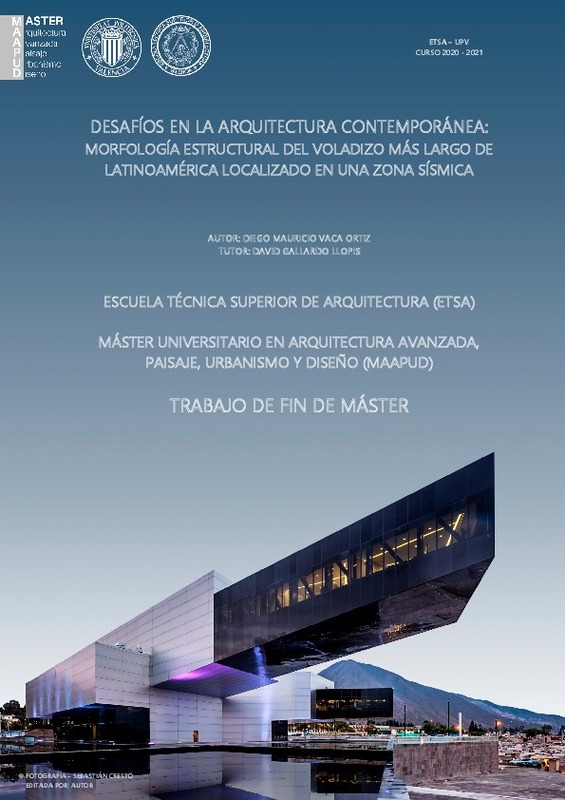JavaScript is disabled for your browser. Some features of this site may not work without it.
Buscar en RiuNet
Listar
Mi cuenta
Estadísticas
Ayuda RiuNet
Admin. UPV
Desafíos en la arquitectura contemporánea: morfología estructural del voladizo más largo de Latinoamérica localizado en una zona sísmica.
Mostrar el registro sencillo del ítem
Ficheros en el ítem
| dc.contributor.advisor | Gallardo Llopis, David
|
es_ES |
| dc.contributor.author | Vaca Ortiz, Diego Mauricio
|
es_ES |
| dc.coverage.spatial | east=-78.45390728054659; north=-0.00405511539252472; name=XGWW+MHW Helipad, Quito, Equador | es_ES |
| dc.date.accessioned | 2021-10-21T11:02:55Z | |
| dc.date.available | 2021-10-21T11:02:55Z | |
| dc.date.created | 2021-09-20 | |
| dc.date.issued | 2021-10-21 | es_ES |
| dc.identifier.uri | http://hdl.handle.net/10251/175238 | |
| dc.description.abstract | [ES] La arquitectura contemporánea del siglo XXI está marcada por los desafíos tecnológicos. Actualmente se advierte, que en cualquier parte del mundo se diseñan nuevos proyectos vanguardistas, con alto nivel de técnica, tecnología y sostenibilidad, muchos de ellos planteados por Archistars, arquitectos estrella, que son capaces de plantear desafíos a la arquitectura establecida. Se puede notar, que esta nueva generación se apoya en la tecnología, materiales y técnicas constructivas nuevas, que se van desarrollando de una manera constante y cada vez más rápida. En Ecuador, la arquitectura contemporánea ha tenido una evolución importante y sustancial, consiguiendo recientemente imponerse en el medio latinoamericano y mundial. En los últimos 20 años se ha logrado dar un salto importante hacia la competitividad y el desarrollo de nuevas tendencias arquitectónicas. Aún queda mucho por hacer, pero se puede destacar que la arquitectura ecuatoriana puede competir a nivel mundial. Como ecuatoriano, tengo el desafío de dar a conocer al mundo de lo que somos capaces de hacer y proyectar. Muchos hemos tenido la posibilidad de formarnos y capacitarnos en una universidad extranjera, y queremos aprovechar la experiencia ganada para poder aplicarla en nuestro país, y así colaborar con el desarrollo de nuestra cultura arquitectónica. La arquitectura es una expresión artística que va más allá de crear y diseñar espacios habitables y confortables para el ser humano. Se trata también de desafiar lo establecido. Gracias al desarrollo de nuevas tecnologías creadas por el ser humano, nos situamos en un punto de la historia en donde la arquitectura se reinventa día a día, en cada lugar del planeta, generando proyectos de arquitectura desafiante de la gravedad. En Latinoamérica, y específicamente en mi país, Ecuador, se han planteado esos mismos desafíos y destacando el trabajo del arquitecto DIEGO GUAYASAMÍN HERNÁNDEZ, quien ha sido reconocido como uno de los arquitectos jóvenes más influyentes en la arquitectura contemporánea del Ecuador. Su herencia artística y plástica, adquirida tanto por su padre, el arquitecto modernista Gustavo Guayasamín; y también de su tío, el gran pintor Oswaldo Guayasamín, marcaron en él un instinto artístico inigualable, vinculado claramente con su estilo arquitectónico. En su corta carrera ha generado varios proyectos con una estética y tendencia vanguardista, su proyecto más galardonado hasta hoy es la SEDE DE LA UNASUR, localizado a 14 km de la ciudad de Quito, un proyecto que marcó un hito tanto estructural como arquitectónico en el continente, llegando a tener el voladizo más largo de Latinoamérica con 56 metros de longitud y que además está situado en una zona sísmica, lo que marca una mayor complejidad en su planteamiento y diseño. El análisis de la morfología estructural de esta obra es el objeto del presente trabajo de Fin de Máster. Para ello, en primer lugar, se ha llevado a cabo un proceso de recopilación de datos y documentos importantes del proyecto y su estructura, alguno de ellos facilitados por el propio arquitecto y su equipo de colaboradores. Todo el material recopilado ha servido para adentrarme en el proceso de análisis del proyecto, desde la arquitectura hasta la estructura, para lo cual me he apoyado en los recursos tecnológicos aprendidos en el Máster. | es_ES |
| dc.description.abstract | [EN] Contemporary architecture of the 21st century is marked by technological challenges, now we see that anywhere in the world new avant-garde projects are being designed, with a high level of technique, technology and sustainability, many of them proposed by Archistars, renowned architects who are able to pose challenges to the established architecture, we can notice that this new generation relies on technology, materials and new construction techniques that are being developed in a constant and increasingly faster way. In Ecuador, contemporary architecture has had an important and substantial evolution, it has gradually managed to impose itself in the Latin American and world environment, in the last 20 years it has managed to make an important leap towards competitiveness and the development of new architectural trends, there is still much to do, but we can emphasize that our architecture can compete globally; As an Ecuadorian, I have the challenge of making known to the world what we are capable of doing and projecting, many of us have had the opportunity to train in a foreign university, and we want to take advantage of the experience gained to apply it in our country, and thus collaborate with the development of our architecture. We have understood that architecture is an artistic expression that goes beyond creating and designing habitable and comfortable spaces for human beings, it is also about challenging the established; and thanks to the development of new technologies created by human beings, we are in a place in history where architecture reinvents itself every day, in every place on the planet, generating gravity-defying architectural projects; In Latin America and specifically in my country, Ecuador, we have posed these same challenges and I want to highlight the work of the architect DIEGO GUAYASAMÍN HERNÁNDEZ, who has been recognized as one of the most influential young architects in contemporary architecture in Ecuador, and it is thanks to his artistic and plastic heritage, acquired both by his father, the modernist architect Gustavo Guayasamín; and also from his uncle, the great painter Oswaldo Guayasamín, marked in him a unique artistic instinct clearly linked to his architectural style, in his short career he has generated several projects with an aesthetic and avant-garde trend, his most awarded project to date is the UNASUR HEADQUARTERS, located 14 km from the city of Quito, a project that marked a milestone both structurally and architecturally in the continent, reaching the longest cantilever in Latin America with 56 meters in length and is also located in a seismic zone, which marks a greater complexity in its approach and design. The analysis of the structural morphology of this work is the subject of this Master's thesis, for this, firstly, a process of data collection and important documents of the project and its structure has been carried out, some of them provided by the architect himself and his team of collaborators, all the material collected has helped me to enter into the process of analysis of the project, from the architecture to the structure, for which I have relied on the technological resources learned in the Master's degree. | es_ES |
| dc.format.extent | 317 | es_ES |
| dc.language | Español | es_ES |
| dc.publisher | Universitat Politècnica de València | es_ES |
| dc.rights | Reserva de todos los derechos | es_ES |
| dc.subject | Diego Guayasamín Hernández | es_ES |
| dc.subject | Sede de la UNASUR | es_ES |
| dc.subject | Voladizos en la Arquitectura | es_ES |
| dc.subject | Arquitectura Atemporal | es_ES |
| dc.subject | Estructura Metálica | es_ES |
| dc.subject | Arquitectura Sísmica | es_ES |
| dc.subject | Disipadores Sísmicos | es_ES |
| dc.subject | Levitación | es_ES |
| dc.subject | UNASUR HEADQUARTERS | es_ES |
| dc.subject | Cantilevers in Architecture | es_ES |
| dc.subject | Timeless Architecture | es_ES |
| dc.subject | Metallic Structure | es_ES |
| dc.subject | Seismic Architecture | es_ES |
| dc.subject | Seismic Dissipators | es_ES |
| dc.subject | Levitation | es_ES |
| dc.subject.classification | MECANICA DE LOS MEDIOS CONTINUOS Y TEORIA DE ESTRUCTURAS | es_ES |
| dc.subject.other | Máster Universitario en Arquitectura Avanzada, Paisaje, Urbanismo y Diseño-Màster Universitari en Arquitectura Avançada, Paisatge, Urbanisme i Disseny | es_ES |
| dc.title | Desafíos en la arquitectura contemporánea: morfología estructural del voladizo más largo de Latinoamérica localizado en una zona sísmica. | es_ES |
| dc.type | Tesis de máster | es_ES |
| dc.rights.accessRights | Abierto | es_ES |
| dc.description.bibliographicCitation | Vaca Ortiz, DM. (2021). Desafíos en la arquitectura contemporánea: morfología estructural del voladizo más largo de Latinoamérica localizado en una zona sísmica. Universitat Politècnica de València. http://hdl.handle.net/10251/175238 | es_ES |
| dc.description.accrualMethod | TFGM | es_ES |
| dc.relation.pasarela | TFGM\144867 | es_ES |
Este ítem aparece en la(s) siguiente(s) colección(ones)
-
ETSA - Trabajos académicos [4687]
Escuela Técnica Superior de Arquitectura







